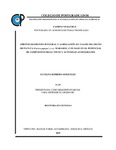Aprovechamiento integral y agregación de valor del fruto de papaya (Carica papaya L.) cv. maradol, con base en el potencial de compuestos bioactivos y actividad antioxidante.
Abstract
La papaya es un fruto tropical de alto consumo en México por su sabor agradable, además, de sus propiedades benéficas para el sistema digestivo. Este fruto contiene compuestos bioactivos con actividad antioxidante, a los cuales se les ha dado poco énfasis. Por lo anterior, en el presente trabajo de investigación se planteó como objetivo caracterizar el fruto de papaya (Carica papaya L.) cv. Maradol, a través de parámetros fisicoquímicos, análisis de compuestos bioactivos y actividad antioxidante para generar alternativas de agregación de valor con base en la situación actual del cultivo. El trabajo se realizó con frutos de huertos comerciales de productores del municipio de Cotaxtla, Veracruz. Se realizó una encuesta a productores y se colectaron frutos en diferentes estados de madurez, determinando humedad, sólidos solubles totales (SST), pH, acidez titulable (AT), firmeza, color, proteína, fibra, cenizas, fenoles totales (FT), actividad antioxidante (AA) y la presencia de ácidos grasos. Se utilizó un diseño completamente al azar, con tres repeticiones. Los datos se trabajaron bajo un análisis de varianza y prueba de Tukey a un nivel de significancia del 5%. El principal destino de la producción de frutos de papaya es para el mercado nacional y solo el 5% es de exportación. Esto se debe a la falta en el cumplimiento de los requisitos fitosanitarios, dado que los productores no aplican buenas prácticas agrícolas (BPA). La percepción de los productores sobre el aprovechamiento del fruto para la agregación de valor resultó en una actitud positiva, ya que el 56.3% mencionó estar interesado en dar algún tipo de aprovechamiento. La presencia de proteína en la cáscara presentó el máximo porcentaje 8.88%, seguida de la semilla con 6.14% y pulpa 2.18%. En fibra los valores fueron de 18.6% en semillas, 11.4% en cáscara y pulpa presentó el 10.8%. Los fenoles totales variaron de 200 a 1506 mg GAE 100 g-1 d.w., en relación a la parte analizada. Los antioxidantes mostraron valores en pulpa 485, cáscara 1539.1 y semilla 935.1 µM TE g-1 d.w, bajo el método ABTS. Respecto la pulpa de papaya conservada al vacío los mejores resultados los presentó el sorbato de potasio en combinación con benzoato de sodio. La caracterización del fruto permitió generar alternativas de valor para el aprovechamiento integral de la papaya. Los productores necesitan opciones rentables que den valor agregado al fruto mediante procesos de conservación, ya que actualmente sólo se comercializa en fresco. _______________ INTEGRAL USE AND ADD OF VALUE OF THE FRUIT OF PAPAYA (Carica papaya L.) cv. MARADOL, BASED ON THE POTENTIAL OF BIOACTIVE COMPOUNDS AND ANTIOXIDANT ACTIVITY. ABSTRACT: Papaya is a tropical fruit of high consumption in Mexico for its pleasant taste, in addition, its beneficial properties for the digestive system. This fruit contains bioactive compounds with antioxidant activity, which have been given little emphasis. Therefore, in this research work, the objective was to characterize the fruit of papaya (Carica papaya L.) cv. Maradol, through physicochemical parameters, analysis of bioactive compounds and antioxidant activity to generate value aggregation alternatives based on the current crop situation. The work was carried out with fruits from commercial orchards of producers in the municipality of Cotaxtla, Veracruz. A survey of producers was carried out and fruits were collected in different stages of maturity, determining humidity, total soluble solids (TSS), pH, titratable acidity (TA), firmness, color, protein, fiber, ash, total phenols (TF), antioxidant activity (AA) and the presence of fatty acids. A completely randomized design was used, with three repetitions. The data were worked under an analysis of variance and Tukey test at a significance level of 5%. The main destination of papaya fruit production is for the national market and only 5% is for export. This is due to the lack of compliance with phytosanitary requirements, since producers do not apply good agricultural practices (GAP). The perception of the producers on the use of the fruit for the aggregation of value resulted in a positive attitude, since 56.3% mentioned being interested in giving some kind of use. The presence of protein in the shell showed the highest percentage 8.88%, followed by the seed with 6.14% and pulp 2.18%. In fiber, the values were 18.6% in seeds, 11.4% in shell and pulp presented 10.8%. Total phenols varied from 200 to 1506 mg GAE 100 g-1 d.w., in relation to the part analyzed. The antioxidants showed values in pulp 485, shell 1539.1 and seed 935.1 µM TE g-1 d.w, under the ABTS method. Regarding the vacuum-preserved papaya pulp, the best results were presented by potassium sorbate in combination with sodium benzoate. The characterization of the fruit allowed the generation of value alternatives for the integral use of papaya. Producers need profitable options that give added value to the fruit through conservation processes, since it is currently only sold fresh.
Collections
- Tesis MC, MT, MP y DC [227]


